Page 6 of 33 pages « First < 4 5 6 7 8 > Last »
Brush washer, lotus leaf shape
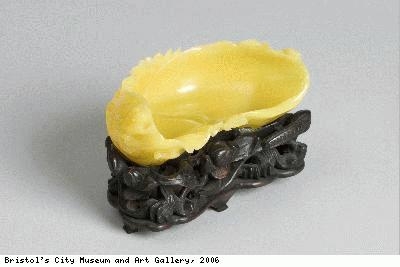
Description:
This brush-washer has the shape of a lotus leaf with finely carved lotus buds and a frog. Chinese scholars liked to have things on their desks that reminded them of nature.
Glass
Height: 6.5 cm, width: 11.3 cm, depth: 5.6 cm
Chinese Description:
笔洗 中国,清代,约1700-1800 这只笔洗形制精致,青蛙藏身于莲叶、花蕾间,充满自然生趣,正是读书人案头实用而又可供玩赏的文具。 玻璃Creator: Unknown
Date: 1700-1800, Qing dynasty
Copyright: Bristol Museums, Galleries & Archives
Object ID:N4773
Saucer, possibly a mixing ink or paint
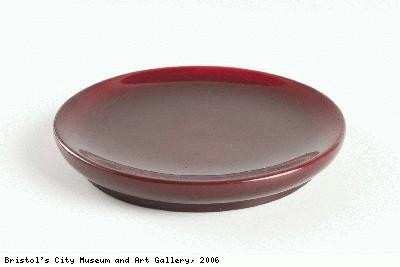
Description:
Artists sometimes used a number of small dishes like this to mix ink or paint.
Glass
Height: 1.0 cm, diameter: 6.5 cm
Chinese Description:
画碟 中国,清代,约1800-1900 书画家或会采用这类画碟调色设墨。 玻璃Creator: Unknown
Date: 1800-1900, Qing dynasty
Copyright: Bristol Museums, Galleries & Archives
Object ID:N4634
Water-pot for calligraphy
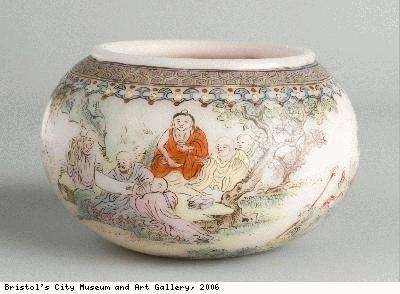
Description:
The painted decoration shows the Eighteen Buddhist Luohans, the personal disciples of the Buddha and guardians of his religion. Each side of the water-pot shows a different episode of their story, as if it were a scroll painting.
At the end of the scroll is an imitation of a red sealmark with the words guyuexuan “ancient moon pavilion”. This was a hallmark coined in the late 19th century, to denote the finest palace-style enamel painting on porcelain of the 18th century.
Glass, painted in enamel colours
Height: 5.6 cm, diameter: 8.8 cm, neck diameter: 6.0 cm
Chinese Description:
书法水丞 中国,清代 约1870-1900 这水丞所画的八大罗汉,不但是佛陀的亲传弟子,更为佛教护法。胎体各面讲述罗汉不同的故事,尤如一幅国画长卷。 玻璃,珐瑯彩绘Creator: Unknown
Date: 1870-1900, Qing dynasty
Copyright: Bristol Museums, Galleries & Archives
Object ID:N4723
Burial accessory in the form of cicada
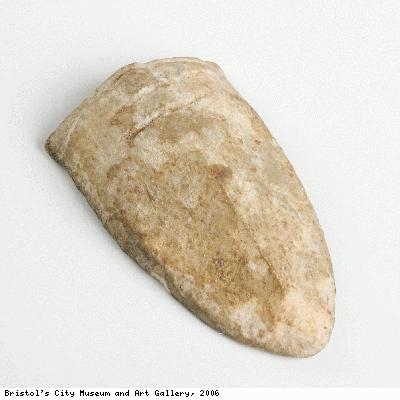
Description:
In ancient China cicadas were symbols of re-birth because of their unusual life cycles.
Young cicadas spend many years underground as larvae before they crawl out and shed their skins, emerging as winged adults.
The dead were often buried with small objects in the shape of cicadas on their tongues in the hope that they would be re-born. The wealthiest people were buried with jade cicadas. These are glass versions which were cheaper to make.
The details of the design was cut by placing the glass against a fast spinning wheel covered with abrasive sand.
Glass, wheel-cut
Width: 1.2 cm, length: 3.9 cm, depth: 0.9 cm
Chinese Description:
琀蝉 中国,大约公元100-300年,东汉晚期(公元25-220年)或西魏(公元265-316年) 蝉的生命周期与众不同,在古代中国被视为重生的象征。幼蝉在地下蛰伏数载,才爬出地面蜕变成一只长有翅膀的成虫。 死者下葬时,多在舌头放置一只蝉形饰物,祈求得以再生。 玻璃,轮刻Creator: Unknown
Date: About 100-300 A.D.
Copyright: Bristol Museums, Galleries & Archives
Object ID:N4807
Object in the shape of a magnolia bud
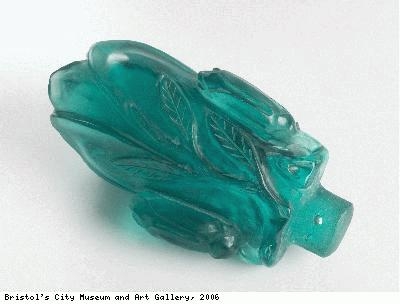
Description:
We are not sure about the original use of this piece. It might have been a stopper to fit into another object such as a bottle. In the past the buds, fruit and bark of the magnolia were used in medicine to cure illnesses like anaemia. The magnolia blossom was also a symbol of a beautiful woman.
Glass, carved
Width: 6.0 cm, length: 11.0 cm, depth: 5.4 cm
Chinese Description:
玉兰花状配件 中国,清代,约1800-1900 这物件或许用作瓶子的钮盖,而配座则由象牙制成的。过去玉兰花花蕾、果实及茎部皆可入药,以治疗贫血等病症。玉兰花清雅,更是美女风华脱俗的象征。 玻璃,碾琢﹔象牙Creator: Unknown
Date: 1800-1900, Qing dynasty
Copyright: Bristol Museums, Galleries & Archives
Object ID:N4600
Brush washer
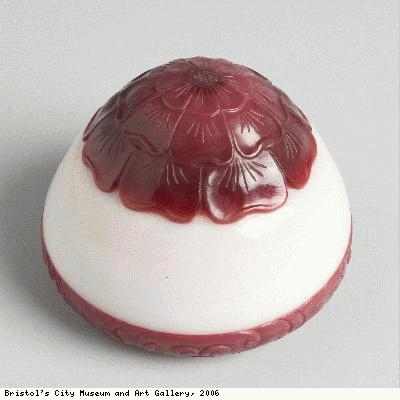
Description:
This unusual shape is similar to a Buddhist monk’s begging bowl, although it is unlikely to have been used for that purpose as it is too delicate. The imperial workshops probably used Buddhist designs like this because Buddhism was popular in the Chinese court at this time. This piece may originally have had a wooden stand to hold it in the correct position.
Glass, carved overlay
Height: 7.4 cm, diameter: 9.5 cm
Incised four-character mark of Qianlong (1736-1795), of the period
Chinese Description:
套料钵盂洗 中国,清乾隆朝(1736-1795) 这件水盂仿效僧侣用的钵盂,形制精致,或许不会作洗笔、盛水之用。当时清廷上下崇信佛教,宫廷造办处出产不少这类与佛教相关的设计。这件器皿还可能配上木座,以便家居摆饰。 玻璃,套料雕刻 刻有「乾隆年制」四字Creator: Unknown
Date: Qianlong reign period (1736-1795)
Copyright: Bristol Museums, Galleries & Archives
Object ID:N4679
Brush pot
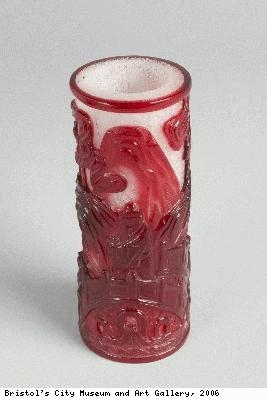
Description:
This pot was made to hold brushes, with the tips up to avoid damage, for calligraphy or painting. The carved decoration shows some of the ‘Eight Immortals’ (Buddhist saints) in a paradise landscape. Two of them are playing chess, a popular pastime in China.
Glass, carved overlay
Height: 10.7 cm, diameter: 4.2 cm
Incised four-character mark of Qianlong reign (1736-1795) but later in date
Chinese Description:
八仙纹饰笔筒 中国,清代,约1770-1900 笔筒可供倒放画笔,以免破坏毛笔尖头。这只文具镂刻着身处蓬莱异境的八仙,其中二仙正悠闲的下棋。 玻璃,套料雕刻 刻有「乾隆年制」四字,疑为后人所加Creator: Unknown
Date: 1770-1900, Qing dynasty
Copyright: Bristol Museums, Galleries & Archives
Object ID:N4667
Brush pot
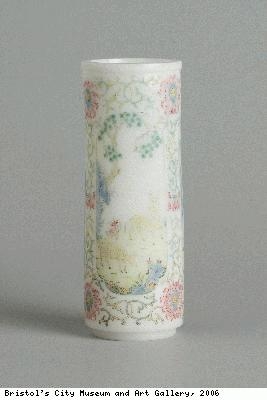
Description:
The person who first owned this brush pot probably understood easily the lucky symbols in its three panels:
The three rams with the sun (san yang kai tai) are a play on words meaning a new start with auspicious (promising/favourable) possibilities and chances for wealth.
The picture refers to the cosmic force yang in the yin / yang model of harmony in the universe. The word for ram (yang) sounds the same and the sun is thought to be the most powerful source of yang energy.
Cranes and a pine tree, both symbols of long life.
Deer and a pine tree, both symbols of long life.
Glass, painted in enamels
Height: 11.0 cm, diameter: 4.1 cm
Creator: Unknown
Date: 1800-1850, Qing dynasty
Copyright: Bristol Museums, Galleries & Archives
Object ID:N4724
Brush pot
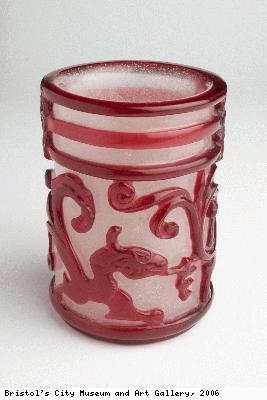
Description:
Two dragons curl around this brush pot.
Glass, carved overlay
Height: 11.0 cm, diameter: 7.7 cm
Chinese Description:
双龙纹笔洗 中国,清代,约1800-1900 这件笔洗镂刻着两条游龙。 玻璃,套料雕刻Creator: Unknown
Date: 1800-1900, Qing dynasty
Copyright: Bristol Museums, Galleries & Archives
Object ID:N4666
Brush pot
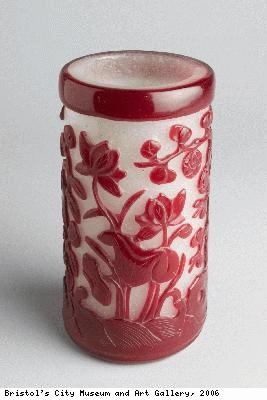
Description:
The carved decoration shows the Flowers of the Four Seasons: prunus, camellia, peony and lotus standing for winter, spring, summer and autumn.
Glass, carved overlay
Height: 14.7 cm, diameter: 7.1 cm
Chinese Description:
四季花纹笔洗 中国,清代,约1800-1900 这只笔洗雕饰着代表四季的牡丹、莲花、茶花及梅花。 玻璃,套料雕刻Creator: Unknown
Date: 1800-1900, Qing dynasty
Copyright: Bristol Museums, Galleries & Archives
Object ID:N4665

